2020 MERCEDES-BENZ GLS SUV light
[x] Cancel search: lightPage 228 of 682
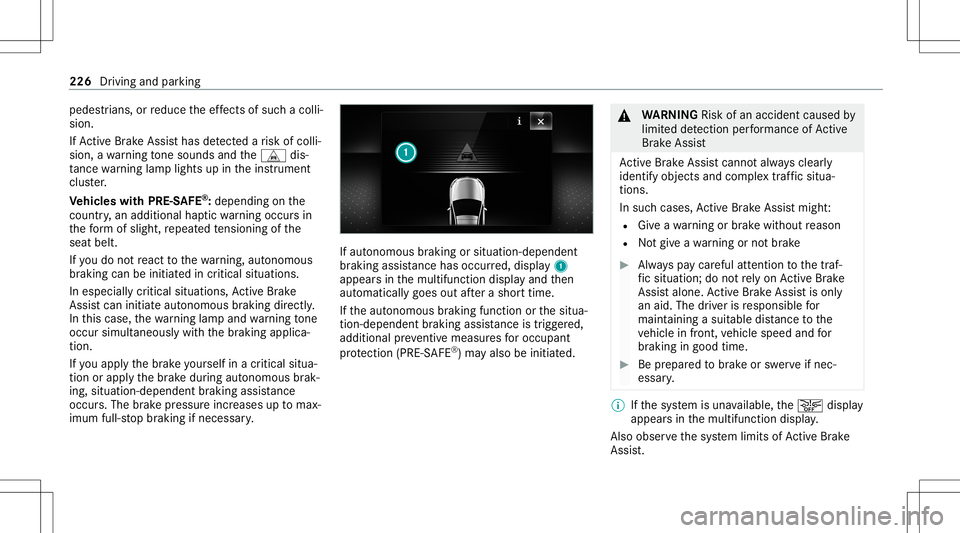
pedes
trians, orreduce theef fects ofsuch acol li‐
sion .
If Ac tiveBr ak eAssi sthas detected arisk ofcolli‐
sion, awa rning tone sou nds and theL dis‐
ta nce warning lam plight sup intheins trument
clus ter.
Ve hicl eswith PRE-S AFE®
:depe nding onthe
cou ntry,an addit ionalhap ticwarning occursin
th efo rm ofslight, repeat edtensi oni ng ofthe
seat belt.
If yo udo notre act tothewa rning, autono mous
br akin gcan beinit iated incritic alsituat ions.
In espec iallycr itic alsituat ions,Ac tiveBr ak e
Assi stcan initia te aut onomo usbrakin gdir ect ly.
In this case, thewa rning lam pand warning tone
occu rsi mu ltane ously with thebr aking applica‐
tion .
If yo uappl yth ebr ak eyo urself inacr itical situa‐
tio nor appl yth ebr ak edur ing autonomous brak‐
ing, situation -dependen tbr aking assistance
occu rs.The brak epr ess ureincr eases uptomax‐
imum full-sto pbr aking ifnec essar y. If
aut onomous braking orsitua tion-dependent
br aking assistanc ehas occurred, displa y1
appear sin themultifunc tiondispla yand then
aut omaticall ygoes outafte ra shor ttime.
If th eaut onomous braking function orthesitua‐
tion -dependen tbr aking assistance istrig ge red,
additional preve ntiv emea suresfo roccupa nt
pr otect ion (PRE-S AFE®
)ma yalso beinitiat ed. &
WARNIN GRisk ofan acci dent caused by
limit eddetection perform anc eof Active
Br ak eAssi st
Ac tiveBr ak eAssi stcanno tal wa ys cle arly
ident ifyobje ctsand complextraf fic situ a‐
tions .
In such case s,Ac tiveBr ak eAssi stmight :
R Giveawa rning orbrak ewit hout reason
R Notgiv eawa rning ornotbr ak e #
Alw ayspa ycar eful attention tothetra f‐
fi c situ ation; donotre ly on ActiveBr ak e
Assi stalon e.Ac tiveBr ak eAssi stisonl y
an aid. Thedriver isresponsible for
maint ainingasui table distance tothe
ve hicle infront, vehicle speed andfor
br aking ingood time. #
Beprepar edtobrak eor sw erve ifnec ‐
essar y. %
Ifth esy stem isuna vailable, the00D4 displa y
appear sin themultifunc tiondispla y.
Als oob ser vethesy stem limits ofActiveBr ak e
Assi st. 226
Driving andparking
Page 229 of 682
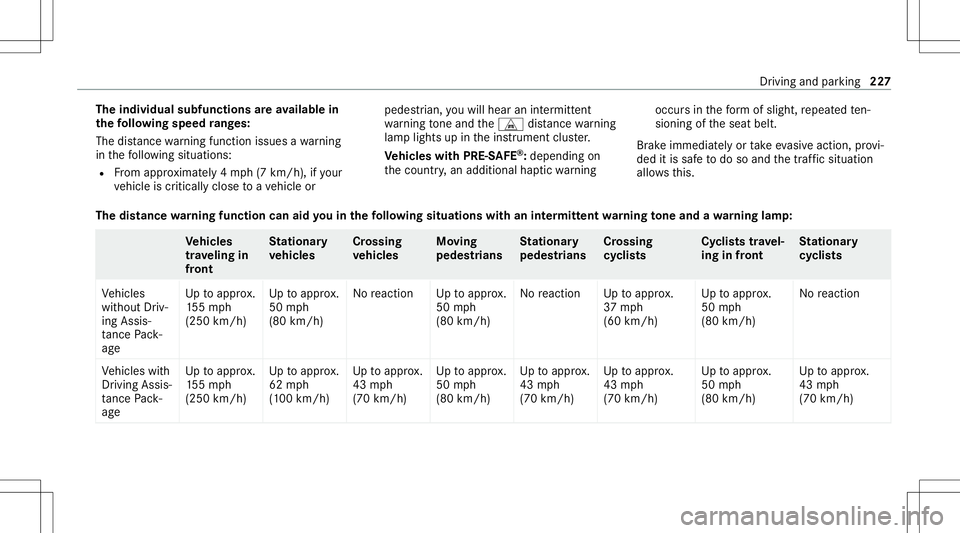
The
indiv idua lsub func tions areav ailab lein
th efo llo wing speed rang es:
The distance warning func tion issues awa rning
in thefo llo wing situat ions:
R From appr oximat ely4 mp h(7 km/h), ifyo ur
ve hicle iscritically closetoave hicle or pedes
trian, youwill hear anintermit tent
wa rning tone and theL distance warning
lam plight sup intheins trument cluster.
Ve hicl eswith PRE-S AFE®
:depe nding on
th ecount ry,an addition alhap ticwarning occ
ursin thefo rm ofslight, repeat edten‐
si oni ng oftheseat belt.
Br ak eimmediat elyortake evasiv eact ion,pr ov i‐
ded itis saf eto do soand thetra ffic situat ion
allo wsthis.
Th edis tance warning funct ioncan aidyouin thefo llo wing situations withan intermit tent wa rning tone and awa rning lam p: Ve
hicl es
tr av eling in
fr ont St
ation ary
ve hicl es Cr
oss ing
ve hicl es Mo
ving
pedes trians St
ation ary
pedes trians Cr
oss ing
cy cli sts Cy
clis tstrave l‐
ing infront St
ation ary
cy cli sts
Ve hicles
wit hout Driv‐
ing Assis‐
ta nce Pack‐
ag e Up
toappr ox.
15 5mp h
(250 km/h) Up
toappr ox.
50 mph
(80 km/ h) No
react ion Uptoappr ox.
50 mph
(80 km/ h) No
react ion Uptoappr ox.
37 mph
(60 km/ h) Up
toappr ox.
50 mph
(80 km/ h) No
react ion
Ve hicles with
Dr iving Assis‐
ta nce Pack‐
ag e Up
toappr ox.
15 5mp h
(250 km/h) Up
toappr ox.
62 mph
(1 00 km/ h) Up
toappr ox.
43 mph
(70 km/ h) Up
toappr ox.
50 mph
(80 km/ h) Up
toappr ox.
43 mph
(70 km/ h) Up
toappr ox.
43 mph
(70 km/ h) Up
toappr ox.
50 mph
(80 km/ h) Up
toappr ox.
43 mph
(70 km/ h) Dr
iving andparking22
7
Page 232 of 682
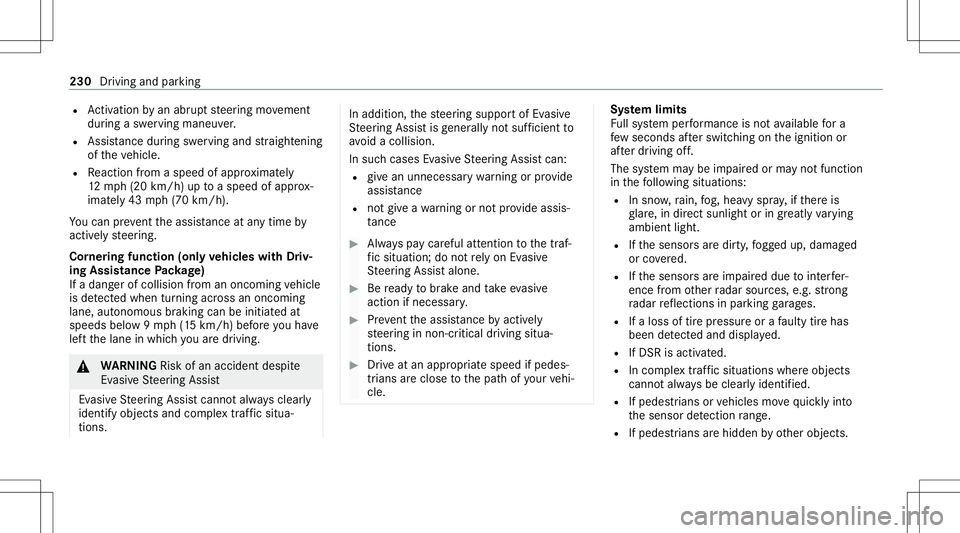
R
Activati on byan abr uptst eer ing movement
dur ing asw erving maneu ver.
R Assi stanc edur ing swervin gand stra ight enin g
of theve hicle.
R React ion from aspee dof appr oximat ely
12 mp h(20 km/h) uptoaspee dof appr ox‐
imat ely43 mph(70 km/h).
Yo ucan preve nttheassis tance atanytime by
act ivel yst eer ing.
Cor nering function (onlyve hicl eswith Driv‐
ing Assistanc ePa ckag e)
If adang erofcoll ision from anoncoming vehicle
is de tected whe ntur ning across anoncomi ng
la ne, autonomo usbraki ng can beinitia tedat
speeds below9mp h(1 5 km/h) beforeyo uha ve
lef tth elane inwhic hyo uar edr ivin g. &
WARNIN GRisk ofan acci dent despite
Ev asive St eer ing Assis t
Ev asiv eSt eer ing Assis tcann otalw aysclear ly
ident ifyobje ctsand complextraf fic situ a‐
tions . In
addition, thesteer ing suppor tof Evasiv e
St eer ing Assis tis ge ner ally no tsu fficien tto
av oid acollision.
In suc hcases Evasiv eSt eer ing Assis tcan:
R givean unnec essarywa rning orprov ide
assis tance
R notgi ve awa rning ornotpr ov ide assis‐
ta nce #
Alw ayspa ycar eful attention tothetra f‐
fi c situ ation; donotre ly on Evasiv e
St eer ing Assis talone. #
Beready tobrak eand take evasiv e
act ion ifnec essar y. #
Preve nttheassis tance byact ivel y
st eer ing innon -critical driving situa‐
tion s. #
Drive at an appr opriatespeed ifpedes‐
tr ians areclose tothepat hof your vehi‐
cle. Sy
stem limit s
Fu llsy stem perform anc eis no tav ailable fora
fe w sec ond saf te rswi tching ontheignition or
af te rdr iving off.
The system maybe impair edorma yno tfunc tion
in thefo llo wing situat ions:
R Insno w,rain, fog, hea vyspr ay,if th er eis
gl ar e, indir ect sunlight oringrea tly varying
ambien tlight .
R Ifth esensor sar edir ty,fo gg ed up, damag ed
or covered.
R Ifth esensor sar eim pair eddue tointerfer‐
ence from other radar sour ces, e.g.stro ng
ra dar reflect ions inpar king garage s.
R Ifaloss oftirepr essur eor afa ulty tirehas
been detected and displ aye d.
R IfDS Ris activ ated.
R Incom plextra ffic situat ionswher eobje cts
can notalw aysbe clear lyident ified.
R Ifpedes trians orvehicles movequickl yint o
th esensor detection rang e.
R Ifpe destrians arehidde nby other objects . 230
Driving andparking
Page 234 of 682
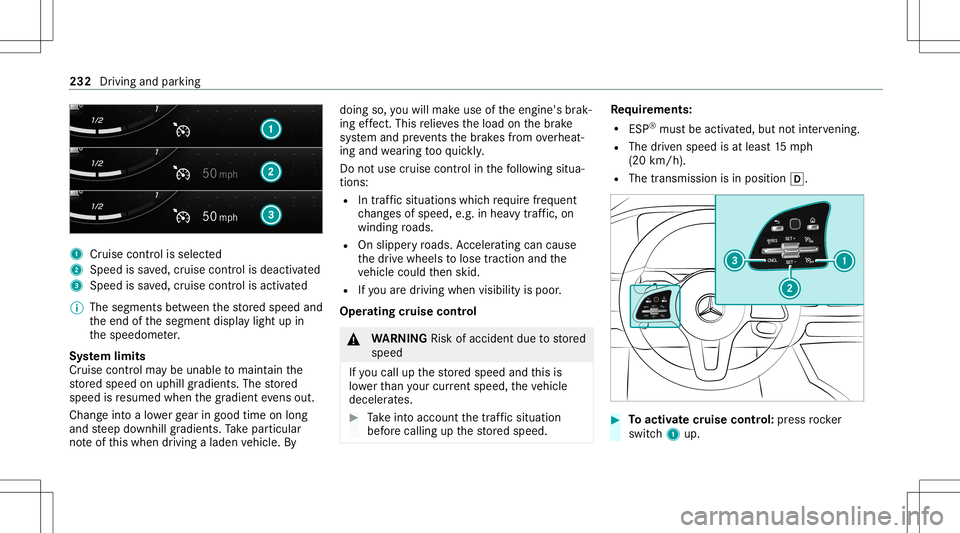
1
Cruise contro lis selec ted
2 Spee dis save d, cruise control isdeactiv ated
3 Speed issave d, cruise control isactiv ated
% The segmen tsbetween thestor ed speed and
th eend ofthesegment displaylight upin
th espeedome ter.
Sy stem limit s
Cr uise control ma ybe unable tomaint ainthe
st or ed speed onuphill gradients. Thestor ed
speed isresumed whenthegr adient evensout.
Ch ang eint oalowe rge ar ingood timeon long
and steep downhill gradients. Take par ticular
no te ofthis when drivin galaden vehicle. By doing
so,youwill mak euse oftheengine' sbr ak‐
ing effect. Thisre lie vesth eload onthebr ak e
sy stem and preve nts thebr ak es from overheat‐
ing and wearing tooqu ickl y.
Do notus ecr uise contr olinthefo llo wing situa‐
tion s:
R Intraf fic situ ations whichrequ ire freq uent
ch ang esofspee d,e.g .in hea vytraf fic, on
wi nding roads.
R Onslippe ryroads. Accel erati ng can cause
th edr ive wheels tolose tract ion and the
ve hicle could then skid.
R Ifyo uar edr ivin gwhen visibilit yis poor .
Ope ratin gcr uis eco ntr ol &
WARNIN GRisk ofacci dent dueto stor ed
speed
If yo ucall upthestor ed speed andthis is
lo we rth an your cur rent spe ed,th eve hicle
deceler ates. #
Take intoacc ount thetra ffic situat ion
bef orecallin gup thestor ed speed. Re
quirement s:
R ESP®
mus tbe act ivat ed, but notint erve ning .
R The driven spe edisat leas t15 mp h
(20 km/ h).
R The transmis sionisin positio n005B. #
Toactiv atecr uise contr ol: press rock er
switc h1 up. 232
Driving andparking
Page 236 of 682
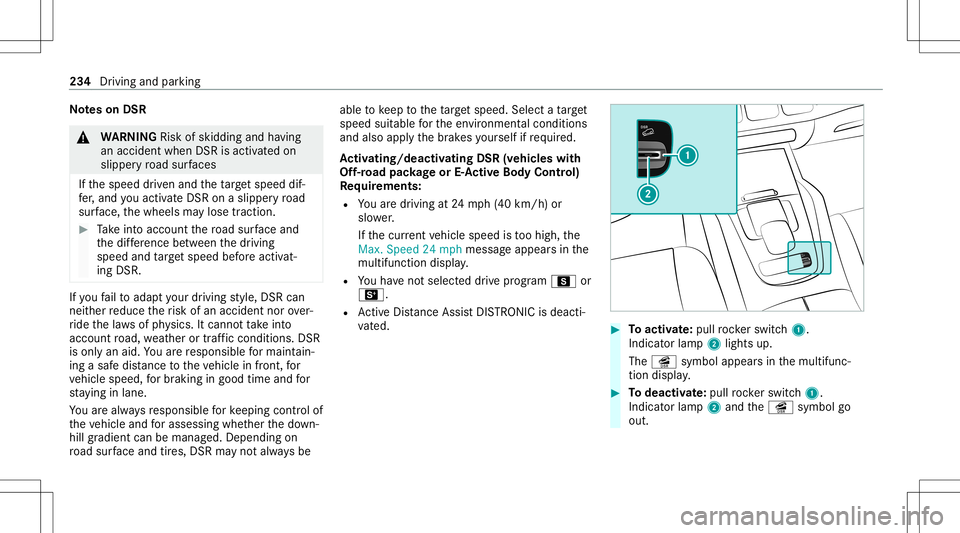
No
teson DSR &
WARNIN GRisk ofskid ding and having
an acci dent whenDSR isacti vatedon
slipper yro ad sur faces
If th espeed driven and theta rget speed dif‐
fe r, and youact ivat eDS Ron aslipp eryro ad
sur face, thewheels maylose traction. #
Take intoacc ount thero ad sur face and
th edif fere nce betwee nth edr iving
speed andtarget speed beforeactiv at‐
ing DSR. If
yo ufa ilto adap tyo ur drivin gst yle, DS Rcan
neit her reduce therisk ofan accident norover‐
ri de thelaws ofphysics. Itcan notta ke into
acc ount road, weather ortraf fic condi tions.DSR
is only anaid. Youar ere sponsible formaint ain‐
ing asaf edis tance totheve hicle infront, for
ve hicle speed, forbr aking ingood timeandfor
st ay ing inlane.
Yo uar ealw aysre sponsible forke eping control of
th eve hicle andforasse ssing whether thedo wn‐
hill gradient canbemanag ed.Depen dingon
ro ad sur face and tires, DSR mayno tal wa ys be able
tokeep totheta rget speed. Selectata rget
speed suitable forth een vironmen talcon dition s
and also apply thebr ak es yourself ifre qu ired.
Ac tiv atin g/deac tivatin gDS R(vehi cles with
Of f-road package orE-Ac tiv eBody Contr ol)
Re quirement s:
R Youar edr ivin gat 24 mp h(40 km/h) or
slo wer.
If th ecur rent vehicle speed istoohigh, the
Max. Speed 24mph messag eappear sin the
multifu nctiondisplay.
R Youha ve notsel ect eddrive pr ogr am C or
B.
R ActiveDis tance AssistDIS TRONI Cis de acti ‐
va ted. #
Toactiv ate: pul lro ck er switc h1.
Indic ator lam p2 lights up.
The î symbol appearsin themultifunc ‐
tion displa y. #
Todeac tivate: pullro ck er switc h1.
Indic ator lam p2 and theî symbol go
out. 23
4
Driving andparking
Page 238 of 682

th
ese tspeed. Thespeed anddistance tothe
ve hicle infront arese tand save don thesteer ing
wheel onvehicles without theDr iving Assistance
Pa ckag e, inthera ng ebe twee n15 mp h
(20 km/ h)and 120mp h(200 km/h) and,on
ve hicles withth eDr iving Assistance Packag e, in
th era ng ebe twee n15 mp h(20 km/h) and
13 0mp h(210 km/h) .The maximu mspe edis
re duced whendriving inLOW RANGEoff-r oa d
ge ar (/ page20 4).
Ot her featur esofActiveDis tan ceAssi st
DIS TRONI C:
R Adjus tsthedr iving style depending onthe
select eddrive pr ogra m(fuel efficie nt, com‐
fo rtable ordynam ic)(/ page19 6)
R Vehicl eswith Drivin gAss istanc ePa ck‐
ag e:react sto statio naryve hicles detected in
urb anspe edrang es (exc ep tbicy cles and
mo torcyc les)
R Initiates acc eler ation tothestor ed speed if
th etur nsignal indicat orisswitc hedonto
ch ang eto theove rtakin glane
R Vehicl eswith Drivin gAss istanc ePa ck‐
ag e:take sone-sided overtakin gre strictions int
oacco untonhighwaysor on multi-lane
ro ads withsepar atero adw ays(countr y-
dependen t)
Ve hicl eswith Activ ePa rking Assis tand Driv‐
ing Assis tance Packag e:ifth eve hicle has
been brak ed toast ands tillon mult i-lane,sepa‐
ra te roadw aysby ActiveDis tance Assist
DIS TRONI C,itcan automatical lyfollo wtheve hi‐
cle infront driving offag ain within 30seconds. If
a cr itical situation isde tected whe ndr ivi ng off,a
vis ualand acoustic warning isgiv en indic ating
th at thedr iver mus tno wtak econ trol of theve hi‐
cle. The vehicle isno tacceler ated anyfur ther.
Ac tiveDis tance AssistDIS TRONI Cis only anaid.
The driver isresponsible forke eping asaf edis‐
ta nce totheve hicle infront, forve hicle speed
and forbr aking ingood time.
Sy stem limit s
The system maybe impair edorma yno tfunc tion
in thefo llo wing situat ions:
R Insno w,rain, fog, hea vyspr ay,if th er eis
gl ar e, indir ect sunlight oringrea tly varying
ambien tlight . R
Ifth er eis swir ling dust,e.g. when driving off-
ro ad oron san dysur faces.
R The windsh ield inthear ea ofthecamer ais
dir ty,fo gg ed up, damag edorcovered.
R Ifth era dar sensor sar edir tyor covered.
R Inpar kingga rage sor on roads withsteep
uphill ordownhill gradients.
R Ifth er ear enar row vehicles infront, suchas
bicy cles ormo torcyc les.
In addition ,on slipper yro ads, brakin gor acc el‐
er atin gcan caus eon eor severalwheels tolose
tr act ion and theve hicle could then skid.
Do notuse ActiveDis tance AssistDIS TRONI Cin
th ese situation s. 236
Driving andparking
Page 243 of 682

R
Traf fic jams ahead(only with Liv eTr af fic
( / pag e406) )
% When theto llst atio nis reac hed, ActiveDis ‐
ta nce AssistDIS TRONI Cad op tsthespeed as
th estor ed speed.
Also, thespeed isreduced ifth etur nsignal indi‐
cat ortochang elane sis swit ched on and one of
th efo llo wing situat ionsisde tected:
R Turning offat intersect ions
R Drivin gon slowing- down lanes
R Drivin gon lanes adjacenttoslo wing-do wn
lanes
The driver isresponsible forch oosing theright
speed andobser vingother road user s.This
applies inpar ticular tointersect ions,traf fic cir‐
cle sand traf fic lights, asroute-based speed
adap tatio ndo es notbr ak eth eve hicle toast and‐
st ill.
When routeguidan ceisact ive, thefirs tsp ee d
ad jus tment iscar ried out automaticall y.Ifth e
tur nsigna lind icatoris switc hedon,theselect ed
ro uteis co nfirmed andfurther speed adjustment
is activ ated. Speed
adjustmentis canc eled inthefo llo wing
cases :
R Ifth etur nsignal indicat orisswitc hedoff
bef oreth ero uteeve nt.
R Ifth edr iver depr esses theacceler ator or
br ak epedal during thepr ocess.
Sy stem limit s
Ro ute-based speedadap tatio ndo es notta ke
ri ght ofwa yre gulations intoaccount .The driver
is responsible forcom plying withro ad traf fic
re gulations anddriving atasuit able speed.
In dif ficul tcondi tions,fo rex am ple unc lear roads,
lane narrowing, wetro ad sur faces, snowor ice ,
or whe ndr ivi ng with atrailer ,th espeed adjust‐
ment made bythesy stem mayno talw aysbe
suit able. Inthese situation sth edr iver mus t
int erve ne acco rding ly. &
WARNIN GRisk ofacci dent inspi teof
ro ute-based speedadj ustm ent
Ro ute-based speedadj ustm entmigh tmal‐
fun ction orbe temp orarily una vailable inthe
fo llo wing situat ions: R
Ifth edr iver does notfo llo wthecalcula‐
te dro ute
R Ifmap datais no tup todat eor available
R Inroad con stru ction area s
R Inbadwe ather orroad con dition s
R Ifth eaccelera torpeda lis depr essed
R Intheeve ntofelectr onicallydispla yed
speed limitations #
Adjus tth espeed tothetraf fic situ ation. Se
tting rout e-base dspee dadap tation Re
quirement s:
R ActiveDis tance AssistDIS TRONI Cis acti va‐
te d. Dr
iving andparking 24
1
Page 245 of 682
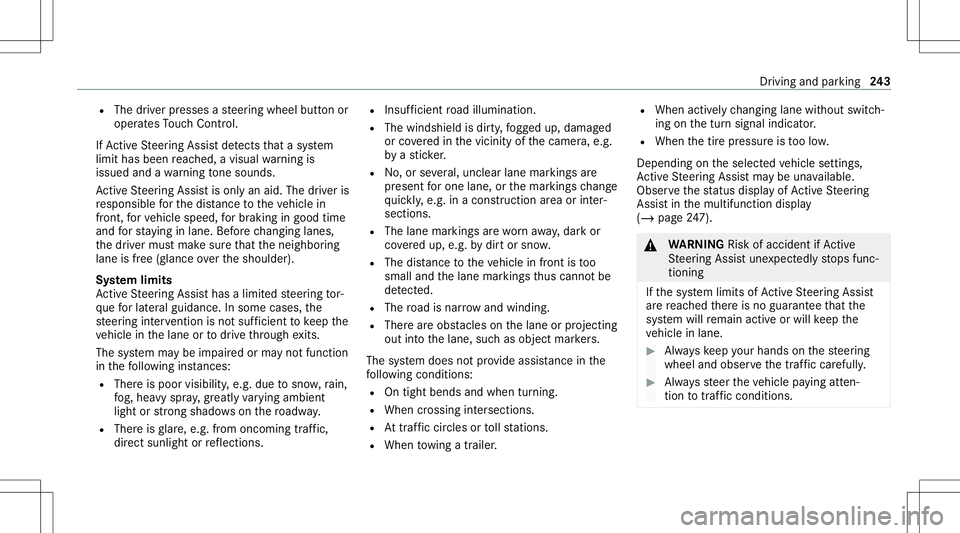
R
The driver presses ast eer ing wheel buttonor
oper ates Touc hCon trol.
If Ac tiveSt eer ing Assis tde tects that asy stem
limit hasbeen reac hed, avisual warning is
issued andawa rning tone sou nds.
Ac tiveSt eer ing Assis tis onl yan aid. Thedriver is
re sponsible forth edis tance totheve hicle in
fr ont, forve hicle speed, forbr aking ingood time
and forst ay ing inlane. Beforech ang inglane s,
th edr iver mus tmak esur eth at theneighbor ing
lane isfree (glance over theshoulder).
Sy stem limit s
Ac tiveSt eer ing Assis thas alimit edsteer ing tor‐
qu efo rlat eral gui dance. Insome cases, the
st eer ing interve ntio nis no tsu fficien tto keep the
ve hicle inthelane ortodrive th ro ugh exits.
The system maybe impair edorma yno tfunc tion
in thefo llo wing instances:
R The reispoor visibilit y,e.g. due tosno w,rain,
fo g, hea vyspr ay,gr ea tly varying ambien t
light orstro ng sha dows onthero adw ay.
R Ther eis glar e, e.g .fr om oncom ingtraf fic,
di re ct sunli ght orreflect ions. R
Insuf ficie ntroad illumin ation.
R The wind shieldisdir ty,fo gg ed up, damag ed
or coveredin thevicinit yof thecamer a,e.g.
by ast icke r.
R No, orseveral,unc lear lane markingsare
pr esen tfo rone lane, orthemar kings chang e
qu ickl y, e.g. inacon stru ction area orinter‐
secti ons.
R The lane mar kings arewo rnaw ay,dar kor
co veredup, e.g. bydirtor sno w.
R The distance totheve hicle infront istoo
small andthelane marking sth us can notbe
de tected.
R The road isnar row and windin g.
R Ther ear eobs tacle son thelane orprojec ting
out intoth elane, suchas objec tmar kers.
The system does notpr ov ide assis tance inthe
fo llo wing condition s:
R Ontigh tbends andwhen turnin g.
R When crossin gint ersect ions.
R Attraf fic cir cle sor tollst atio ns.
R When towing atrailer . R
When activel ych ang inglane without switch‐
ing onthetur nsignal indicat or.
R When thetir epr essur eis toolow.
Dep endingontheselect edvehicle settin gs,
Ac tiveSt eer ing Assis tma ybe una vailable.
Obser vethest atus displa yof ActiveSt eer ing
Assis tin themultifunc tiondispla y
(/ page24 7). &
WARNIN GRisk ofacci dent ifAc tive
St eer ing Assis tune xpect edlystops func‐
tionin g
If th esy stem limits ofActiveSt eer ing Assis t
ar ere ac hed ther eis no guar anteethat the
sy stem will remain activeor wil lke ep the
ve hicle inlane. #
Alw ayske ep your han dson thesteer ing
wheel andobser vethetra ffic car efull y. #
Alw aysst eer theve hicle paying atten‐
tion totraf fic condi tions. Dr
iving and parking 24
3